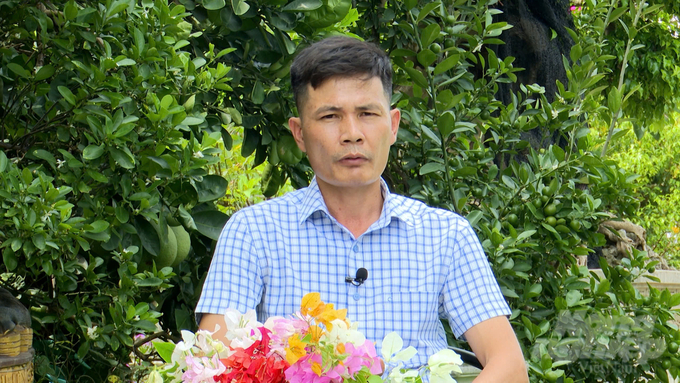June 1, 2025 | 23:54 GMT +7
June 1, 2025 | 23:54 GMT +7
Hotline: 0913.378.918
June 1, 2025 | 23:54 GMT +7
Hotline: 0913.378.918

Flower farmers in Van Giang District, Hung Yen Province, are currently enjoying an income of 1 to 1.5 billion VND per hectare. Photo: Duy Hoc.
"Urban agriculture" was previously a novel concept to the farmers of Hung Yen Province; however, it has developed significantly in suburban areas and even within urban zones. With the current rapid pace of urbanization, urban agriculture is both an essential solution and an inevitable trend.
“The idea of producing clean and safe vegetables in urban areas might seem difficult to imagine in the past; however, high-tech approaches such as hydroponics have almost become a systematic and streamlined process that every farmer can access and master,” commented Nguyen Van Kien, General Director of the Hung Yen Province's Agricultural Extension Center.
For instance, households within a hub for flowers and ornamental plants in Van Giang District, Hung Yen Province, have incorporated high-tech solutions into their production process. These solutions, with notable examples including greenhouses, shade nets, and automated drip irrigation systems, have yielded relatively high economic efficiency. Farmers typically earned between 50 and 100 million VND per hectare from rice cultivation in the early 2000s. After converting to flower farming, these farmers enjoyed an income of 1 to 1.5 billion VND per hectare. This transition clearly illustrated the transformation of agricultural structure and the application of advanced technology in production.
Hung Yen Province boasts one of the highest rates of urbanization and industrialization nationwide. The rapid pace of these processes has led to a shrinking agricultural land area. Additionally, the declining and aging agricultural labor force is unable to meet the demands of modern production practices.
Consequently, Hung Yen’s agricultural sector has identified the adoption of high technology in production as a viable development trend against the current global background. Accordingly, high technology enables stakeholders to address labor and climate change challenges. As a result, farmers can produce agricultural goods that achieve both high productivity and quality, thereby meeting the increasingly strict market demands.

Nguyen Van Hanh, Deputy Head of Crop Production at Hung Yen Province's Department of Agriculture and Rural Development, stated that the province will focus on effective planning activities based on the potential and strengths of each region. Photo: Duy Hoc.
Nguyen Van Hanh highlighted an obstacle in the development of urban agriculture as the requirement for sufficient food production to meet the needs of urban areas. Consequently, the Department of Agriculture and Rural Development has provided consultations on various mechanisms and policies to address practical demands for the Hung Yen Provincial People's Committee.
Accordingly, the province must first prioritize effective planning based on the key strengths of each region. For instance, Van Giang District has an advantage in terms of ornamental flowers and plants, whereas Khoai Chau District has an advantage in fruit farming. Other areas such as Tien Lu, Phu Cu, Kim Dong, and An Thi boast the ideal conditions for staple crop production.
Secondly, Hung Yen must focus on organizing production by building and directing large-scale specialized farming areas that follow safety standards such as VietGAP or organic practices. This specialization will create high-quality products that generate economic value and meet domestic consumer demand. These products will also be available for distribution to other regions and export.
“We are also promoting our communication and support efforts to form highly specialized cooperatives. Additionally, we are focusing on product promotion, trade facilitation, and market distribution activities. Hung Yen Province has implemented various policies within the last few years in order to enhance agricultural production. Several notable policies included encouraging a shift from rice to higher-value crops in accordance with market demand,” explained Nguyen Van Hanh.
Moreover, Hung Yen Province is focusing on land consolidation activities to establish large-scale concentrated farming areas. This movement enables the increased use of mechanization and high technology in production. On the other hand, the province also prioritizes educating and guiding farmers to meet modern production requirements.
Hung Yen's provincial plan for the years between 2021 and 2030, with a vision towards 2050, outlines several key tasks, including: restructuring and developing agriculture towards high technology, circular agriculture, organic farming, and ecological agriculture; promoting large-scale, high-value specialized farming; and expanding production areas for flowers, ornamental plants, specialty crops, livestock, and agricultural products that boast the province's competitive advantage.
Translated by Nguyen Hai Long

(VAN) Several scientists and farmers are experimenting with soil treatment in some key durian-growing regions such as Cai Lay (Tien Giang), Dak Song, Gia Nghia, and Dak R’lap (Dak Nong).
/2025/05/25/4127-3-073637_820.jpg)
(VAN) Thanks to the promotion from an FAO-implemented project, vegetable production in greenhouses in Moc Chau has seen strong development, from 1.5 hectares in 2021 to nearly 50 hectares in 2024.

(VAN) FAO has recently supported USD 140,000 to implement the project 'Risk mitigation human-animal interface risks through disease control initiatives in pig farming.'

(VAN) The People's Committee of Tra Vinh province has approved an adjustment to the investment policy for the Green Hydrogen Plant project, increasing its area to approximately 52.76 hectares.
![Reducing emissions from rice fields: [2] Farmers’ commitment to the soil](https://t.ex-cdn.com/nongnghiepmoitruong.vn/608w/files/news/2025/05/05/dsc08881jpg-nongnghiep-140632.jpg)
(VAN) Clean rice cultivation model in Thuong Tan commune, Bac Tan Uyen district, is assisting local residents in achieving sustainable agriculture by substantially reducing costs, increasing productivity, and protecting the environment.

(VAN) At the conference to disseminate Resolution No. 68, AgriS introduced its digital agricultural ecosystem and reaffirmed its commitment to accompanying the Government in promoting private sector development and sustainable agriculture.

(VAN) 'Blue Ocean - Blue Foods' initiative is designed to restore marine ecosystems and establish sustainable livelihoods for local communities by cultivating a minimum of 1,000 hectares of cottonii seaweed in the first three years.